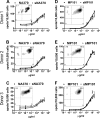Assessment of seasonal influenza A virus-specific CD4 T-cell responses to 2009 pandemic H1N1 swine-origin influenza A virus
- PMID: 20071564
- PMCID: PMC2838145
- DOI: 10.1128/JVI.02226-09
Assessment of seasonal influenza A virus-specific CD4 T-cell responses to 2009 pandemic H1N1 swine-origin influenza A virus
Abstract
Very limited evidence has been reported to show human adaptive immune responses to the 2009 pandemic H1N1 swine-origin influenza A virus (S-OIV). We studied 17 S-OIV peptides homologous to immunodominant CD4 T epitopes from hemagglutinin (HA), neuraminidase (NA), nuclear protein (NP), M1 matrix protein (MP), and PB1 of a seasonal H1N1 strain. We concluded that 15 of these 17 S-OIV peptides would induce responses of seasonal influenza virus-specific T cells. Of these, seven S-OIV sequences were identical to seasonal influenza virus sequences, while eight had at least one amino acid that was not conserved. T cells recognizing epitopes derived from these S-OIV antigens could be detected ex vivo. Most of these T cells expressed memory markers, although none of the donors had been exposed to S-OIV. Functional analysis revealed that specific amino acid differences in the sequences of these S-OIV peptides would not affect or partially affect memory T-cell responses. These findings suggest that without protective antibody responses, individuals vaccinated against seasonal influenza A may still benefit from preexisting cross-reactive memory CD4 T cells reducing their susceptibility to S-OIV infection.
Figures






Similar articles
-
Pre-existing immunity against swine-origin H1N1 influenza viruses in the general human population.Proc Natl Acad Sci U S A. 2009 Dec 1;106(48):20365-70. doi: 10.1073/pnas.0911580106. Epub 2009 Nov 16. Proc Natl Acad Sci U S A. 2009. PMID: 19918065 Free PMC article.
-
Immunoinformatic comparison of T-cell epitopes contained in novel swine-origin influenza A (H1N1) virus with epitopes in 2008-2009 conventional influenza vaccine.Vaccine. 2009 Sep 25;27(42):5740-7. doi: 10.1016/j.vaccine.2009.07.040. Epub 2009 Aug 4. Vaccine. 2009. PMID: 19660593
-
Infection with seasonal influenza virus elicits CD4 T cells specific for genetically conserved epitopes that can be rapidly mobilized for protective immunity to pandemic H1N1 influenza virus.J Virol. 2011 Dec;85(24):13310-21. doi: 10.1128/JVI.05728-11. Epub 2011 Oct 5. J Virol. 2011. PMID: 21976658 Free PMC article.
-
CD4 T cells in protection from influenza virus: Viral antigen specificity and functional potential.Immunol Rev. 2018 Jul;284(1):91-105. doi: 10.1111/imr.12662. Immunol Rev. 2018. PMID: 29944766 Free PMC article. Review.
-
Novel swine-origin influenza virus A (H1N1): the first pandemic of the 21st century.J Formos Med Assoc. 2009 Jul;108(7):526-32. doi: 10.1016/S0929-6646(09)60369-7. J Formos Med Assoc. 2009. PMID: 19586825 Review.
Cited by
-
Revealing the role of CD4(+) T cells in viral immunity.J Exp Med. 2012 Jul 30;209(8):1391-5. doi: 10.1084/jem.20121517. J Exp Med. 2012. PMID: 22851641 Free PMC article. Review.
-
Repeated vaccination is required to optimize seroprotection against H1N1 in the immunocompromised host.Haematologica. 2011 Feb;96(2):307-14. doi: 10.3324/haematol.2010.032664. Epub 2010 Oct 22. Haematologica. 2011. PMID: 20971824 Free PMC article.
-
Cross-protective immunity against influenza A/H1N1 virus challenge in mice immunized with recombinant vaccine expressing HA gene of influenza A/H5N1 virus.Virol J. 2013 Sep 22;10:291. doi: 10.1186/1743-422X-10-291. Virol J. 2013. PMID: 24053449 Free PMC article.
-
Time for T?: Thoughts about the 2009 novel H1N1 influenza outbreak and the role of T cell epitopes in the next generation of influenza vaccines.Hum Vaccin. 2010 Feb;6(2):161-63. doi: 10.4161/hv.6.2.11333. Epub 2010 Feb 19. Hum Vaccin. 2010. PMID: 20431339 Free PMC article. No abstract available.
-
Integrative Physiology of Pneumonia.Physiol Rev. 2018 Jul 1;98(3):1417-1464. doi: 10.1152/physrev.00032.2017. Physiol Rev. 2018. PMID: 29767563 Free PMC article. Review.
References
-
- CDC. 2009. Serum cross-reactive antibody response to a novel influenza A (H1N1) virus after vaccination with seasonal influenza vaccine. MMWR Morb. Mortal. Wkly. Rep. 58:521-524. - PubMed
-
- Dawood, F. S., S. Jain, L. Finelli, M. W. Shaw, S. Lindstrom, R. J. Garten, L. V. Gubareva, X. Xu, C. B. Bridges, and T. M. Uyeki. 2009. Emergence of a novel swine-origin influenza A (H1N1) virus in humans. N. Engl. J. Med. 360:2605-2615. - PubMed
Publication types
MeSH terms
Substances
Grants and funding
LinkOut - more resources
Full Text Sources
Other Literature Sources
Research Materials
Miscellaneous

